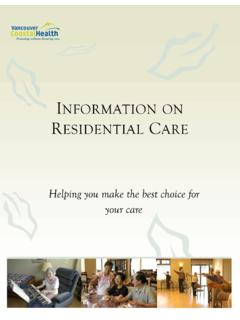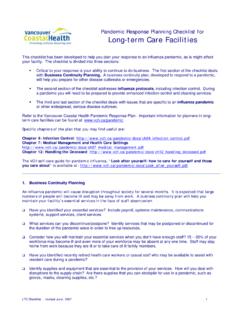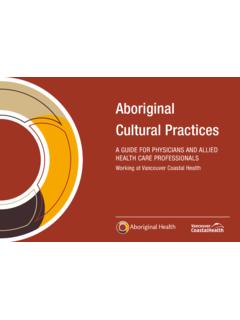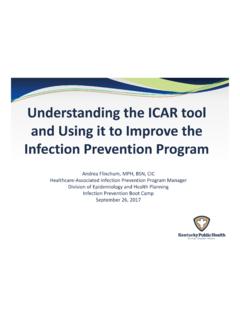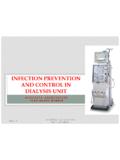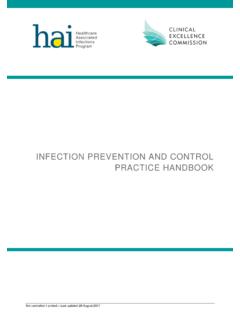Transcription of THE REGIONAL PANDEMIC OUTBREAK RESPONSE …
1 THE REGIONAL PANDEMIC OUTBREAK RESPONSE PLAN September 2018 VCH REGIONAL PANDEMIC OUTBREAK RESPONSE Plan 2 TABLE OF CONTENTS CHAPTER 1 .. 4 OVERVIEW .. 4 - Introduction .. 4 - Objectives .. 7 - Authority .. 7 - RESPONSE .. 8 - Ethical Considerations and Framework .. 9 - Plan Maintenance .. 10 CHAPTER 2 .. 11 SURVEILLANCE .. 11 - Surveillance Overview .. 11 - Routine Surveillance Systems .. 13 - Enhanced Surveillance Systems .. 14 - Resources .. 15 CHAPTER 3 .. 17 INFECTION AND ENVIRONMENTAL CONTROL .. 17 - Infection Control Guidelines .. 17 - Forms and Tools .. 22 CHAPTER 4.
2 26 EMERGENCY MANAGEMENT .. 26 Health Emergency Management BC (HEMBC) .. 26 Emergency RESPONSE .. 26 Consistency with the BC Emergency Management System .. 26 RESPONSE Objectives .. 26 Emergency Operations Centres .. 27 Joint VCH and Providence Health Care (PHC) Corporate Level RESPONSE .. 28 EOC Locations .. 29 EOC Activation Criteria .. 30 World Health Organization PANDEMIC Phases .. 31 Resource Management .. 32 Recovery Operations .. 32 Debriefing, Evaluation and Review .. 33 CHAPTER 5 .. 35 CLINICAL MANAGEMENT .. 35 - Clinical Care .. 36 Acute Care .. 38 - Long-Term Care.
3 40 - Primary Care .. 41 - Forms and Tools .. 42 CHAPTER 6 .. 57 HUMAN RESOURCES .. 57 Human Resources Management .. 57 - Planning for Optimal Use of Health Care Workers .. 58 Management of Public Health Care Resources .. 59 Psychosocial Services for Health Care Providers ..61 CHAPTER 7 .. 62 PUBLIC HEALTH MEASURES .. 62 - Introduction .. 62 Disinfection Measures .. 63 VCH REGIONAL PANDEMIC OUTBREAK RESPONSE Plan 3 - Measures to Increase Social Distance .. 64 - Domestic Travel Measures .. 65 International Travel Advisories .. 65 Measures to Reduce Contact with At-Risk Animals .. 65 Psychosocial Services for the Public.
4 65 Forms and Tools .. 66 CHAPTER 8 .. 71 VACCINES .. 71 - VCH PANDEMIC Vaccine Program .. 71 - PANDEMIC Vaccine Planning .. 71 - Vaccine Distribution and Prioritization .. 72 - Immunization Providers .. 72 - Seek and Immunize Approaches .. 73 - Mass Vaccination Clinics .. 74 - Roles and Responsibilities for Vaccine Program .. 77 - Forms and Tools .. 79 CHAPTER 9 .. 90 ANTIVIRALS .. 90 - VCH PANDEMIC Antiviral Program .. 90 - Roles and Responsibilities for Antivirals .. 90 - Classes of Antiviral Drugs .. 91 - Current National Strategy for Use of Antivirals .. 91 - Adverse Drug Reaction Reporting .. 92 - Distribution Plan.
5 92 CHAPTER 10 .. 94 COMMUNICATIONS .. 94 - Overview .. 94 - Core Communication Committee .. 94 - Key Spokespersons .. 95 - Internal Stakeholders .. 96 - External Stakeholders .. 98 - Vehicles of Communication .. 99 - Key Messages .. 101 VCH REGIONAL PANDEMIC OUTBREAK RESPONSE Plan 4 CHAPTER 1 OVERVIEW Introduction The first priority of a PANDEMIC influenza RESPONSE plan is to save lives and care for the ill, while minimizing social disruption in the community. With this aim, Vancouver Coastal Health established the REGIONAL PANDEMIC Influenza RESPONSE Committee and assigned it the task of researching and developing implementation procedures for areas of responsibility identified in the Canadian Influenza Plan (based on the WHO framework).
6 The REGIONAL PANDEMIC OUTBREAK RESPONSE Plan (RPORP) outlined below is the result of this work. Chapter 1 Overview This PANDEMIC influenza plan elaborates on principles that are primarily intended for execution at the local and REGIONAL levels. We have strived in our planning to be sufficiently flexible to account for the unknown epidemiology of the PANDEMIC virus and the needs of different stakeholders. The OUTBREAK RESPONSE process, key leads and their roles in the RESPONSE are described. Lead: Chief Medical Health Officer Chapter 2 Surveillance Influenza surveillance is required to determine when, where, and which influenza viruses are circulating; the high risk populations; the intensity and impact of influenza activity; and to detect unusual events ( , infection by unusual influenza viruses, unusual syndromes caused by influenza viruses, and unusually large or severe outbreaks of influenza).
7 Both virologic and disease surveillance are necessary for identifying influenza virus variants and for determining their ability to spread and cause disease. Surveillance data will drive the PANDEMIC RESPONSE as it will be used to determine the PANDEMIC phase, and to track progression through the phases. Lead: REGIONAL Director of PHSU Chapter 3 - Infection and Environmental Control Adherence to infection prevention and control policies and procedures minimizes transmission of influenza in health care settings. However it is important to remember that influenza is largely transmitted in the community. Routine practices are important to prevent the transmission of infection during the delivery of health care in all health care settings during a PANDEMIC .
8 Strict adherence to hand hygiene, isolation and containment of respiratory secretions produced by coughing and sneezing are the cornerstones of infection prevention and may at times be the only significant preventative measure available during a PANDEMIC . This chapter provides an overview of infection prevention and environmental control guidelines that will be critical to minimizing the transmission of PANDEMIC influenza. Lead: VCH REGIONAL Medical Director for Infection Prevention and Control, PHSA Director of Infection Control, and Providence Director of Infection Control VCH REGIONAL PANDEMIC OUTBREAK RESPONSE Plan 5 Chapter 4 - Emergency Management The scope of this chapter is to outline Vancouver Coastal Health s (VCH) Emergency Management processes for the REGIONAL PANDEMIC RESPONSE Plan, including; governance, statutory and regulatory compliance, organizational RESPONSE structures and resources within the organization.
9 External RESPONSE structures and their relationship to VCH are also reviewed. Additional documentation to support this Plan ( Emergency Operations Centre Setup/Activation Guide) are available in local Emergency Operations Centre(s). The fundamental concepts and principles outlined in this chapter are consistent with the emergency management activities and measures undertaken throughout British Columbia. This document supports current legal and policy frameworks, programs, activities, standards and other measures that enable VCH to plan and respond effectively and efficiently. This chapter provides a short overview of the structures and process that provide a foundation for the development and execution of the organization s PANDEMIC RESPONSE plan.
10 The mitigation and preparedness activities that enable VCH s RESPONSE and recovery from emergencies and disasters, are numerous and complex. More detailed information can be found within the complete VCH Corporate Emergency Management Plan. Lead: Health Emergency Management BC Lower Mainland West Director Chapter 5 Clinical Management In the early stages of a PANDEMIC , gathering data to characterize the clinical and epidemiologic features of the PANDEMIC influenza strain is a priority. Early surveillance will provide data to assess if and how the mode of transmission, incubation period, period of infectiousness, and most affected populations of the PANDEMIC strain differs from seasonal influenza.


